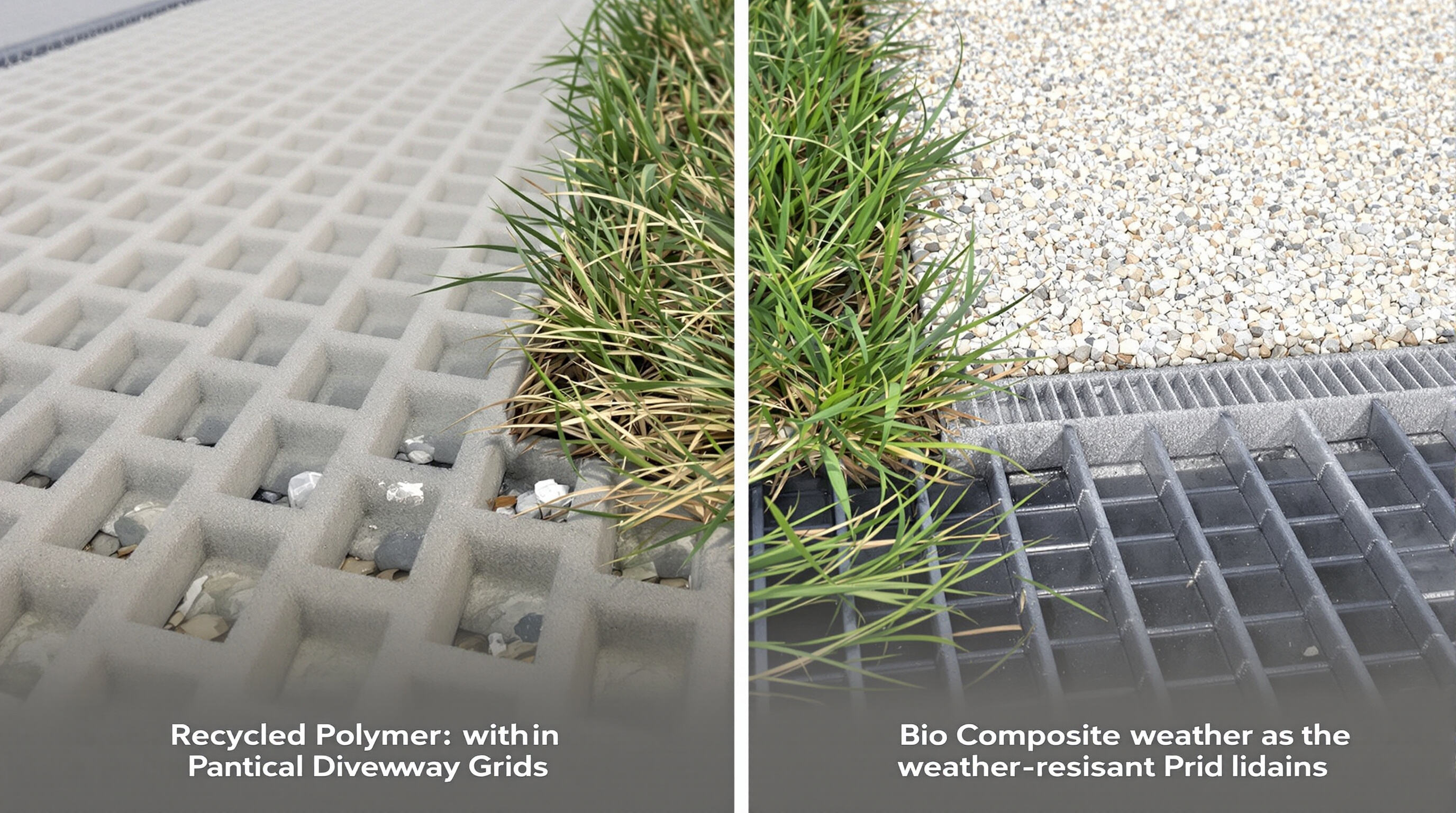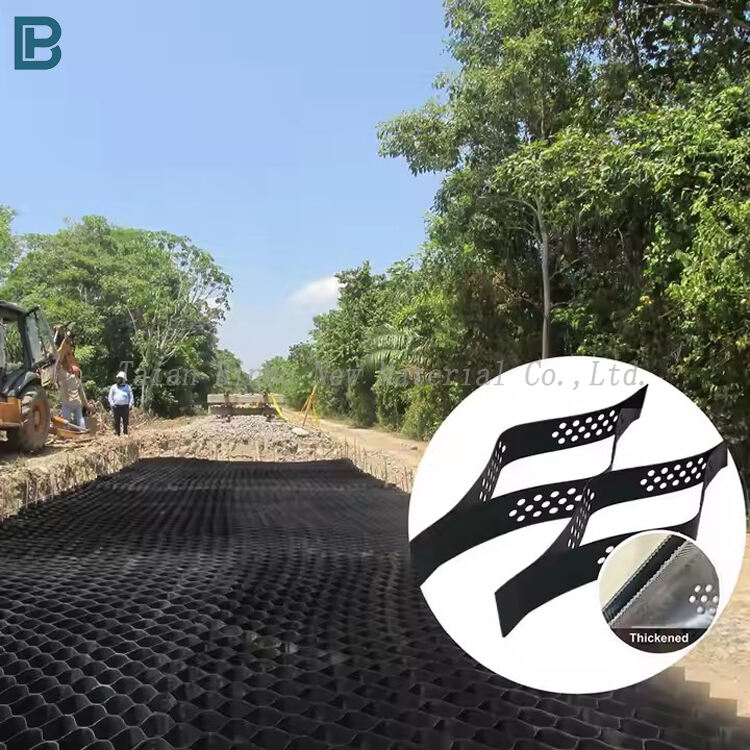Die Umweltwirkung von Auffahrts-Gitter-Systemen
Wie durchlässige Auffahrts-Gitter den städtischen Oberflächenabfluss reduzieren und ein nachhaltiges Entwässerungssystem unterstützen
Studien der University of Sustainable Design aus dem Jahr 2023 zeigten, dass durchlässige Auffahrtsgitter den städtischen Abfluss um 40 bis 75 Prozent reduzieren können, verglichen mit herkömmlichen Betonflächen. Die Funktionsweise dieser Gitter ist tatsächlich ziemlich clever – sie verfügen über eine offene Zellstruktur, die es ermöglicht, dass etwa 30 Gallonen Wasser pro Quadratfuß jede Stunde eindringen können. Das bedeutet, dass mehr Wasser in den Boden gelangt, anstatt abzufließen, was dazu beiträgt, unterirdische Wasserreservoire wieder aufzufüllen und die überlasteten Sturmabflusskanäle zu entlasten, die uns allen nur zu bekannt sind. Auch Städte fangen langsam an, dies zu erkennen, da diese Systeme im Grunde nachahmen, wie die Natur Regenwasser behandelt. Aus diesem Grund haben mittlerweile fast 8 von 10 Gemeinden, die anfällig für Überschwemmungen sind, Vorschriften für durchlässige Gitter in ihre Baunormen aufgenommen. Manche neuere Modelle verfügen sogar über schräg angeordnete Wände innerhalb der Zellen, die den Entwässerungsprozess beschleunigen und gleichzeitig Schmutz sowie Trümmerteile auffangen, bevor diese unsere Flüsse und Bäche verschmutzen können.
Regenwassermanagement: Die Rolle der Infiltration bei der Hochwasserprävention
Studien zeigen, dass Einfahrtsgitter den Regenwasserabfluss während großer Jahrhundertregenereignisse um etwa 58 % reduzieren können, so eine Forschungsveröffentlichung des National Stormwater Institute vom letzten Jahr. Diese Gitter verfügen über eine Öffnungsfläche von rund 94 %, sodass das Wasser einfach hindurchsickern kann, im Gegensatz zu herkömmlichem Asphalt, der alles blockiert. Ein Beispiel ist der Knox County in Tennessee, wo die örtlichen Behörden fast 1.200 Häuser mit solchen Gittersystemen nachgerüstet haben und dadurch Schäden in Höhe von fast 2,1 Millionen US-Dollar verhindert wurden. Die meisten Experten empfehlen zudem, eine Schicht Schotter mit einer Dicke von etwa 6 bis 8 Zoll unterhalb der Gitter anzubringen. Dies schafft zusätzlichen Speicherplatz für Regenwasser, bis es langsam in den darunterliegenden Boden aufgenommen wird. Einige Installateure stellen sogar fest, dass diese Schotterschicht die Installation vereinfacht, da sie das System langfristig stabilisiert.
Fallstudie: Kommunale Einführung von Einfahrtsgitter-Technologie in Öko-Städten
Kopenhagens Klimaplan für 2025 schrieb Drainagegitter für alle Neubauten vor, mit messbaren Ergebnissen:
| Metrische | Vor der Umsetzung (2020) | Nach der Umsetzung (2024) |
|---|---|---|
| Kombinierte Kanalüberläufe | 18 Ereignisse/Jahr | 3 Ereignisse/Jahr |
| Schäden durch Straßenüberflutungen | 4,7 Mio. USD jährliche Reparaturen | 890.000 USD jährliche Reparaturen |
| Grundwasseranreicherungsraten | 12"/Jahr | 19"/Jahr |
Die Stadt erreichte nach vier Jahren eine Rendite auf das investierte Kapital durch reduzierte Infrastrukturbelastung. Zudem berichteten 92 % der Anwohner von einer verbesserten Einfahrtleistung bei extremem Wetter.
Materialinnovation und Langlebigkeit in Einfahrtgitter-Technologie

Recycelte Polymere und Hochdichtekunststoffe im modernen Einfahrtgitterbau
Heutige Auffahrtgitter enthalten etwa 95 % recycelte Polymere, recyceln also alten Plastikmüll und verwandeln ihn in robuste, langlebige Oberflächen, die auch über die Zeit hinweg stabil bleiben. Die verwendeten Materialien sind äußerst stabil, tatsächlich vergleichbar mit Beton, und dieser Ansatz verhindert, dass jährlich rund 2,3 Millionen Tonnen Plastik auf Deponien landen, wie 2023 in der Sustainable Materials Journal veröffentlichte Forschung zeigt. Zudem sind diese modernen Gitter für extreme Wetterbedingungen ausgelegt. Sie bleiben auch bei Temperaturschwankungen von -30 Grad Celsius bis zu 60 Grad Celsius stabil und verformen sich nicht, wie es ältere Kunststoffsysteme oft taten.
Tragfähigkeit: Fahrzeuge werden getragen, während die Bodenintegrität geschützt wird
Auffahrtgitter mit cleveren geometrischen Formen können tatsächlich Achslasten von über 50 Tonnen standhalten, da sie die Last seitlich über die gesamte Oberfläche verteilen. Laut einer aktuellen Studie aus dem Jahr 2024 im Bereich Geotechnik reduzieren diese Gitter die Bodenverdichtung um etwa 72 % im Vergleich zu herkömmlichen Asphaltflächen. Zudem lassen sie weiterhin Wasser mit einer Effizienz von rund 94 % durch, selbst wenn sie über einen längeren Zeitraum konstantem Druck ausgesetzt sind. Das Ergebnis? Eine Bodendeckung, die den darunterliegenden Boden sowie die Pflanzenwurzeln schützt und es ermöglicht, Gras und andere Vegetation direkt durch das Gittersystem wachsen zu lassen. Und trotz all dieser umweltfreundlichen Eigenschaften eignen sich solche Flächen auch problemlos für den Schwerlastverkehr. Feuerwehrautos und Lieferwagen fahren problemlos darüber, was Sinn macht, da das Design speziell für solche Anforderungen entwickelt wurde.
Aufkommender Trend: Bio-Verbundwerkstoffe prägen die Zukunft umweltfreundlicher Auffahrtgitter
Eine neue Generation von bio-kompositen Gittern verbindet landwirtschaftliche Abfälle – wie Reisschalen und Hanffasern – mit Biokunststoffen, um kohlenstoffnegative Pflasterlösungen zu schaffen. Ein Pilotprojekt aus dem Jahr 2023 in Hamburg zeigte, dass diese Materialien:
| Eigentum | Traditioneller Kunststoff | Bio-Komposit |
|---|---|---|
| Zerfallszeitplan | 500+ Jahre | 7–15 Jahre |
| Graue Energie | 3,8 kg CO2/m² | –1,2 kg CO2/m² |
| Produktionsenergie | 85 kWh/m² | 62 kWh/m² |
Frühe Anwender haben eine erhöhte mikrobielle Aktivität unterhalb der Gitter festgestellt, was auf ein Potenzial für sich selbst erhaltende Bodenökosysteme im Laufe der Zeit hindeutet.
Installations-Effizienz und langfristige Wartungsvorteile
Auffahrt-Gittersysteme bieten eine schnelle Installation und erfordern nur minimale Wartung auf lange Sicht, wodurch sie eine praktische und nachhaltige Alternative zu konventionellem Pflaster sind.
Schritt-für-Schritt-Installation: Fertigstellung eines Auffahrt-Gitterprojekts innerhalb von weniger als 48 Stunden
Vorgeschnittene, ineinander greifende Gitterelemente ermöglichen es Teams, 500 Quadratfuß innerhalb von nur ein bis zwei Tagen zu installieren – 65 % schneller als Betonverguss, gemäß Branchenstandards der Landschaftsgestaltung. Der vereinfachte Prozess umfasst:
- Grundfläche auf eine Neigung von 1–2 % ausgleichen, um optimale Entwässerung zu gewährleisten
- Modulare Gitterpaneele ineinander einrasten
- Zellen mit Kies, Rasen oder Harz füllen
Diese Effizienz reduziert Störungen am Bauplatz und ermöglicht eine sofortige Nutzung nach Verdichtung des Füllmaterials.
Langfristige Kosteneinsparungen: Vermeidung von Rissen, Erosion und Reparaturbedarf
Eine Studie der University of Michigan aus dem Jahr 2023 stellte fest, dass Auffahrtgitter die jährlichen Wartungskosten im Vergleich zu Asphalt um 78 % senken. Ihre flexible Polymerkonstruktion widersteht Rissen durch Frosthebung in kalten Klimazonen und verträgt UV-Abbau. Hauseigentümer berichten von 90 % weniger Rissen und keiner Randerosion über einen Zeitraum von 7–10 Jahren, wodurch die Reparaturhäufigkeit und -kosten erheblich reduziert werden.
Leichte Wartung: Unkrautbekämpfung und Reinigungstechniken für Auffahrtgittersysteme
Die Pflege von Auffahrtgittern erfordert minimalen Aufwand:
- Entfernen Sie Schmutz zweimal jährlich mit einem Laubbläser oder einer harten Bürste
- Tragen Sie essigbasierte Herbizide auf, um das Unkrautwachstum innerhalb der Zellen zu unterdrücken
- Reinigen Sie mit Hochdruckreiniger befüllte Gitter bei einem Druck unter 800 PSI, um Schäden zu vermeiden
Diese einfachen Maßnahmen tragen zu einer hohen Benutzerzufriedenheit bei, wobei 82 % der Eigentümer die Wartung in Umfragen des National Home Improvement Council als „leichter als erwartet“ beschreiben.
Ästhetische Vielseitigkeit und Optionen zur Gestaltungsanpassung
Design-Oberflächen: Rasen, Kies und harzgefüllte Auffahrtsgitter-Ästhetik
Auffahrtsgitter bieten drei primäre optische Oberflächen, die zu unterschiedlichen Architekturstilen passen:
- Rasen-gefüllte Gitter erzeugen natürliche, lebende Oberflächen, die sich in die Landschaft integrieren und dennoch vollständig durchlässig bleiben
- Kies-gefüllte Gitter bieten einen rustikalen, strukturierten Look, ohne 94 % Durchlässigkeit einzubüßen
- Harzgebundene Oberflächen stellen ein elegantes, modernes Erscheinungsbild mit individuell anpassbaren Farben und rutschhemmenden Oberflächen bereit
Diese Optionen stellen sicher, dass Nachhaltigkeit nicht auf Kosten des Designs geht.
Trends bei Eigenheimbesitzern: Individuelle Muster und Integration in ökologischen Luxus-Landschaftsbau
Sechsundsechzig Prozent der privaten Installationen weisen nun individuelle Muster auf, wie beispielsweise Fischgrät- oder Sechseck-Anordnungen. Bei Eco-Luxury-Projekten werden Fahrspuren zunehmend mit einheimischen, trockenheitsresistenten Pflanzen sowie solarbetriebener Beleuchtung kombiniert. Dank modularem Fertigungsverfahren lassen sich die Gitter in Farbe und Form anpassen – einschließlich abgerundeter Kanten –, um harmonisch in organische Landschaftsgestaltungen zu integrieren.
Funktionalität und ästhetische Optik in modernen Einfahrtsdesigns vereinen
Auffahrtgitter lösen das lästige Problem, bei dem etwas entweder robust oder gut aussehen muss, aber nicht beides gleichzeitig. Diese Gitter können tatsächlich über 12.000 Pfund pro Rad tragen, sodass normaler Fahrzeugverkehr ihnen nicht schadet. Zudem reißen oder verwittern sie nicht wie herkömmliche Beläge. Wenn sie mit richtig dimensioniertem Kies befüllt oder mit Harz imprägniert werden, haben Unkräuter Schwierigkeiten, Wurzeln zu bilden, wodurch die Fläche ordentlich bleibt, ohne ständige Pflege. Am Ende erhält man somit eine Auffahrtsfläche, die allen Baunormen entspricht, von der Straße aus gut aussieht und mit der Zeit sogar Wertzuwachs für die Immobilie schafft, da sie langlebig ist und sich harmonisch in die umgebende Landschaftsgestaltung einfügt.
FAQ
Was sind Auffahrt-Gitter-Systeme?
Auffahrt-Gitter-Systeme sind Pflasterlösungen, die mit durchlässigen Gittern konzipiert sind und es Regenwasser ermöglichen, in den Boden einzudringen. Dadurch wird Oberflächenabfluss in Städten reduziert und Grundwasserleiter werden wieder aufgefüllt.
Wie tragen Auffahrtgitter zur Hochwasserprävention bei?
Indem sie die Wassereinfiltration in den Boden fördern, reduzieren Einfahrtgitter den Abfluss von Regenwasser und verringern so das Risiko von Überschwemmungen während starker Regenfälle.
Welche Materialien werden bei der Herstellung von Einfahrtgittern verwendet?
Moderne Einfahrtgitter bestehen aus recycelten Polymeren und Hochdichtekunststoffen. Neuere Modelle verwenden zudem biokomposite Materialien, die umweltfreundlich sind und die Kohlenstoffemissionen reduzieren.
Sind Einfahrtgitter für den Fahrzeugverkehr belastbar genug?
Ja, Einfahrtgitter sind so konzipiert, dass sie schweren Fahrzeugbelastungen standhalten. Sie bestehen aus langlebigen Materialien, die auch bei intensivem Verkehr die Bodenintegrität nicht beeinträchtigen.
Welche Wartungsarbeiten sind für Einfahrtgitter erforderlich?
Einfahrtgitter benötigen nur geringe Wartung. Regelmäßiges Reinigen mit einem Besen oder Laubbläser, gelegentliche Anwendung von Herbiziden und Hochdruckreinigung halten sie in optimaler Verfassung.


